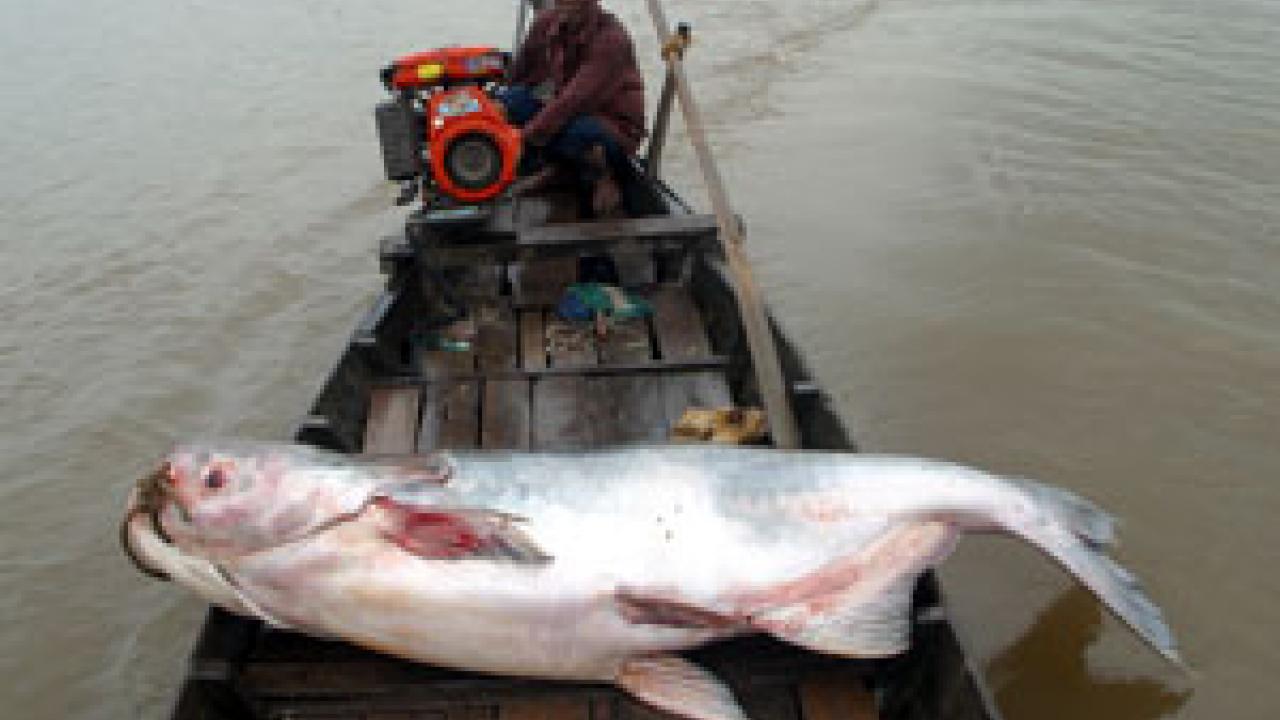In 2000 and 2001, Zeb Hogan, a UC Davis doctoral student in conservation biology, waited the entire month of May for Thai fishers to catch giant catfish in the Mekong River at Chiang Khong. At this traditional fishing spot, 30 fish had been caught in 1995, only seven in 1997, merely two in 1998.
Every day Hogan sat on the patio at his guest house overlooking the river. As the muddy waters rolled by, he typed on his laptop, working through past years' catch data and fishery statistics. Thousands of those fish flowed from his field notes into the computer. No giant catfish swam into the fishers' nets.
"I'd go down to where they had their nets out and ask, 'Caught any fish?' And they never did," Hogan said in a recent interview on campus between stints in Asia. "Here is a fish that has been caught for hundreds of years. Now it looks like it's on the way out.
"I decided to work on this fish's conservation. With a species disappearing before my eyes, the more technical aspects of my research seemed less urgent."
The Mekong River has one of most diverse freshwater fish faunas of the world, says Hogan's doctoral adviser, Peter Moyle. It includes several other giant fishes that regularly reach 6 feet in length, such as the giant carp and freshwater stingray.
Like some of the California native fish that Moyle studies, the Mekong fish migrate hundreds of miles each year between downstream feeding areas and upstream spawning areas.
"The diverse fish fauna supports large fisheries that are extremely important to the health and economic well-being of local peoples -- fisheries now threatened by the construction of hydropower dams and other problems," Moyle said. "We hope that Zeb's work will help call attention to a potential impending ecological and social disaster."
At Chiang Khong, Hogan conceived the idea of paying the fishers to release any catfish they caught. But he was barely scraping by on small grants and the catfish were expensive -- a typical 400-pound fish sold for $3,000. He wasn't sure he could afford to ransom a fish even if he got the chance.
Then he heard of another fishing place 1,000 miles away in Cambodia on the Tonle Sap River. There the same giant catfish (Pangasianodon gigas) had 1/50th the worth of those in Thailand. In 1999, he learned, four of the fish had been caught in the Tonle Sap. After being shut out two years running on the Mekong, Hogan headed for the Tonle Sap.
He arrived a little late in the season; six giant catfish had already been caught and killed. But when five more were caught, Hogan was able to buy, tag and release them. "Ever since then I've arrived on time," Hogan said wryly.
In November 2003, in part because of Hogan's field work, the International Union for Conservation of Nature (IUCN) put the Mekong giant catfish on its Red List of critically endangered species, giving it worldwide attention.
Not many graduate students end up trying to save a fish as big as a bear. But students in conservation biology increasingly find their progress-to-degree delayed by the discovery that the subject of their studies is heading for extinction. "Like Zeb, many of our students find themselves involved in on-the-ground efforts to save species and habitats," Moyle said.
After spending much of 2000-03 mapping the giant catfish's distribution and migratory patterns, Hogan is now resuming his doctoral work. He will tag other species of migratory fish in the Mekong, Tonle Sap and Cambodia rivers and study their genetic makeup to gather information about migration and dispersal.
He's not giving up on the Mekong giant catfish, though. With the help of the Mekong Wetlands Biodiversity Program, an IUCN program, he'll lead a workshop to develop a conservation plan for the fish. It will be the first time that experts in Thailand, Cambodia, Laos and Vietnam meet to discuss conservation options for the Mekong giant catfish.
And in hopes of increasing local public awareness of the giant catfish's endangered status, Hogan has just written a children's book. Published by Save Cambodia's Wildlife, the book is beautifully illustrated by Cambodian artists Srey Bondal and Tor Vutha and printed in Khmer and English.
The book intertwines a story of the seasons of a giant catfish's life with those of a young Cambodian boy named Samnang. When the huge fish, which has become an old friend of Samnang's, is caught by fisherman, Samnang persuades the men to let her go, because he believes that the fish "is special and very rare."
For more information, see http://news.nationalgeographic.com and search for "Mekong catfish".
